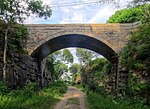Paper House
Buildings and structures completed in 1924Houses in Rockport, MassachusettsMuseums in Essex County, MassachusettsNovelty buildings in MassachusettsUse mdy dates from March 2023

The Paper House is a historic house museum in Rockport, Massachusetts, United States. It was constructed between 1922 and 1924 by American engineer Elis F. Stenman as a summer house. He decided to leave the walls unclad and formed only from their varnished newspaper insulation. He later added furniture constructed from rolled newspaper. By 1927 the house had become a tourist attraction. It is now run as a museum by members of the Stenman family.
Excerpt from the Wikipedia article Paper House (License: CC BY-SA 3.0, Authors, Images).Paper House
Pigeon Hill Street,
Geographical coordinates (GPS) Address Nearby Places Show on map
Geographical coordinates (GPS)
| Latitude | Longitude |
|---|---|
| N 42.672972222222 ° | E -70.634638888889 ° |
Address
The Paper House
Pigeon Hill Street 52
01966
Massachusetts, United States
Open on Google Maps










